“Those who cannot remember the past are condemned to repeat it.” — Spanish-American philosopher George Santayana, 1905
1937 — Hitler and Franco Team Up to Bomb Basque Guernica, Spain
public domain images from wikimedia commons
Adolf Hitler (1889-1945) wanted to give his flyboys some practice, and Francisco Franco (1892-1975) wanted to kill some of his citizens, and so it came to pass: Guernica, a small Basque city with more opposers than supporters of Franco, was bombed on this date in 1937 by the German Luftwaffe (literally, “Air Weapon”).
The result for the small rural city was that, after three hours of bomb-dropping and gun-shooting from the airplanes, one third of the city’s inhabitants had been killed and their city set aflame for days.
The wanton bloodshed provoked outrage around the world, but ultimately the major players in World War 2 (soon to begin) took a page from the Luftwaffe’s playbook and fire-bombed cities during their prosecution of the 6-year-long bloodletting — it wasn’t just Germany bombing London and Coventry and Belfast, but the British bombed Berlin, the Americans bombed Hamburg and Dresden and, more infamously, Hiroshima and Nagasaki … and so on. And so it went.
It has been said that imitation is the most sincere form of flattery.
Questions: Have you seen the Longmire episode Death Came in Like Thunder? Have you read Kurt Vonnegut’s Slaughterhause-Five? Is there ever an excuse for killing civilians, including children and babes-in-arm, along with combatants?
1986 — Chernobyl Fails the Test
public domain image from wikimedia commons
The world’s worst nuclear plant accident occurred on this date in 1986. All it takes is the one placename to conjure up memories for any who were alive and aware of world events in 1986: Chernobyl.
Thirty-two died, and others were injured. The Soviet Union did not report the catastrophe until they had to reluctantly admit the boo-boo when Sweden detected radiation eight hundred miles away.
The previous evening (April 25th) engineers had run some ill-advised, reckless, and mistake-ridden tests that resulted in a reactor exploding and sending 50 tons of radioactive material into the atmosphere. Evacuations and a cover-up attempt followed but, again, Swedish scientists solved the mystery and the Soviets had to come clean.
Millions of acres of land were contaminated by the released poison. There were thousands of down-the-line cancer deaths attributed to the accident, and millions had their health adversely affected.
Questions: What was done with those who had carried out the failed tests? Were they simply fired? Were they charged with a crime? Had they been drinking at the time? Are they “hiding out,” perhaps living as hermits in a remote region, or have they changed their identity and continue to live “hidden in plain sight”? What can prevent future mistakes of this magnitude from ever occurring again?
Read about “The Secret Lives of Kids” here.








